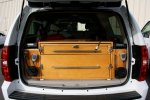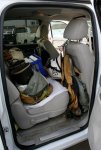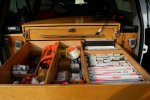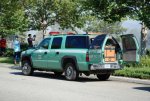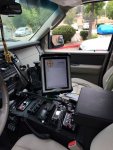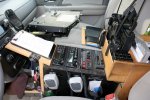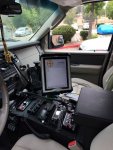The BC driver/aide position can be a good career stepping stone to a captain and above career path.
I remember the simpler days at LA City FD when the command vehicles were sedans, not SUV's when there were fewer radios, no MDT, and only a Thomas Guide and large scale printed maps.
For those who don't know I'm retired from the U.S. Forest Service and worked most of my career in recreation management, with 4 years full time in fire management when I started. I managed to stay in the field most of that time, with a period in lower management, a position I did not care for. I loved being the equivalent of a sergeant, but didn't like the lieutenant level very much. I stayed involved in emergency management my entire career. My observations are based on my experience, however, I retired 20 years ago, just before I reached the age of 50 due to a health condition. I had just short of 25 years though. Some things have changed, but many haven't.
A Thomas Guide was essential for driving in southern California. You also had to know what side of the street various cities place their odd and even addresses. I don't think it was standardized throughout the county or from county to county up to when I left there, for the last time, in 1973. I remember having a sheet of paper taped onto the inside front cover of my guides that explained it. Just a guess, but I think even addresses were on the east and south and odd on the west and north sides of the streets, at least in the city of L.A. I would not call that a simple time. Now there are GPS programs and Google Earth that show you what side of the street an address is on and guide you by voice on your route, without being distracted by a paper map. With Google Earth you can get a picture, which allows you to track where the driveway to parking is and for firefighters shows what the building looks like from the air and at the street level. There are challenges when Google Earth hasn't driven a highway, road or street in over a decade such as in rural areas outside of towns, but in big cities it appears to be every 2-3 years.
I learned of computer programs accessible from fire apparatus that showed what type of business was inside malls and at addresses. This program would show, for example, that a dentist is located on the 3rd floor of a building and has pressurized bottles of nitrous oxide gas stored, something that can be affected by high temperatures of a structure fire. This was explained to me sometime in the 1980's or 1990's and the location referred to was the Del Amo Mall. That mall had a huge variety of business types in it, many that had some special characteristics for emergency responders. The simple days did not include such readily accessible information and firefighters had to make assumptions or simply did not know what they were facing.
The simple days found batt chiefs who didn't have room to store all the equipment they have now. The current SUV's and now pickups with shell campers being used by LAFD are sufficient to serve as full Incident Command Posts for the initial attack phase of incidents. Each department has different configurations of what is built into the rear of those vehicles and most are made by carpenters working for each jurisdiction. In the 90's when I supervised hand crews on wildland fires staged for structure protection at subdivisions I would wander around and talk with BCs of lots of different agencies, which always included a tour of their vehicles. I was amazed that the BC rigs for L.A. County had laptops, printer/copy/FAX machines right in their rigs. This if the fire was some distance away and we had already done the defensive space prep work around the structures. There can be long hours of just sitting around, "just in case." This is why lots of engines have long lengths of surgical hose that are tied to some fabric so water balloons can be sling shot at other engines and people. An ample supply of balloons was stashed somewhere on those engines.
Since I had several job qualifications on my ICS qualifications card (red card) and resource unit leader was one of them, I had a small planning section kit behind the seat of my pickup, complete with a forms file and "T Card" fabric rack to hang wherever I could. It made the transition from initial attack to extended attack very smooth, be that from a Type 4 to Type 3 incident or in a few cases from a Type 4 to a Type 1 due to the explosive nature of a fire. Incoming teams were very appreciative of having everything tracked on the right forms and T Cards right when they started. I also carried maps of every National Forest and large National Parks in California, Nevada and parts of Arizona in my truck. I had a set of full 7.5 minute topo's for the northern 2/3's of the Inyo National Forest in my truck. I carried most of the brochures and one page information handouts we had available in our visitor center. Those proved quite useful for wildland fires, but for search and rescue incidents as well. I was a "Forest Protection Officer" (non armed law enforcement), an on call accident/claims investigator and a on call personnel misconduct investigator (like internal affairs, but not involving criminal law). I carried some tools/supplies for those duties. I carried most of what was needed for hazard tree evaluation. I carried a large set of carboard, poster type signs and a few metal signs for fire and recreation for campgrounds, trailheads and other frontcountry (non-wilderness) areas. My half ton pickup had to go into the shop to replace parts of the suspension and make it as close to a 3/4+ ton pickup due to all the weight of what I carried. Hardware, parts, tools and incident kits add up to a lot of weight. I had some common parts to repair tents, bicycles, backpacks, etc. for myself and the public. I carried a line pack that would sustain me on a fire or other incidents for about 36 hours, 24 hours being the minimum required. I had full GoreTex and fleece uniform components in my pickup year round as I never knew the circumstances I might face. I carried a uniform coverall for real dirty work. I had a small backpacking stove to warm water in case I found a person that needed to be warmed using hot beverages and about 4 gallons of drinking water. My first aid kit was large and carried in a small pack. Management had no objection spending the money on my truck due to the work I could do in the field when the unexpected happened.
I share all of this because that resembles what is carried by BC's, Division Chiefs and Department Chiefs on large departments and agencies. A sedan doesn't have enough luggage space to carry what is needed. Incident size and complexity is far greater today than back in the "good old days," which when evaluated weren't all that good anyway. Nostalgia just isn't what it used to be!!
Here are some pictures of various command or BC type vehicles for your viewing pleasure:
